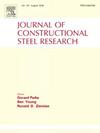Flexural behavior of externally prestressed steel-UHPC-NC composite beams in negative moment regions
IF 4
2区 工程技术
Q1 CONSTRUCTION & BUILDING TECHNOLOGY
引用次数: 0
Abstract
External prestressing and UHPC could significantly improve the mechanical performance of composite beams in the negative moment regions. The flexural behavior of externally prestressed steel-UHPC (ultra-high performance concrete)-NC (normal concrete) composite beams (EPSUNCB) under negative moment was studied through experimental and numerical investigation in this paper. Firstly, three externally prestressed composite beams (EPSNCB, EPSUCB, EPSUNCB) of different concrete flange materials (NC, UHPC, UHPC-NC) and one non-prestressed UHPC-NC composite beam (SUNCB) were experimentally studied under negative moment. The results indicated that the failure modes of the composite beams were characterized by compression buckling of the lower edges of the steel girders and the appearance of bending cracks in the concrete flanges. The cracking load of the prestressed composite beams increased by 118.8 % compared to the non-prestressed composite beam. The UHPC flange resulted in a 148.3 % and 2.5 % increase in cracking load and ultimate load, respectively, compared to the NC flange composite beam. Besides, finite element simulation revealed that increasing initial prestress significantly improved the crack resistance of the composite beams. The ultimate flexural capacity of the composite beams was particularly affected by steel girder strength. Furthermore, considering the tensile strength of UHPC and the strain-hardening effect of steel, a calculation formula for the ultimate flexural capacity of composite beams was proposed and validated through experimental and numerical simulation results.
负弯矩区外预应力钢- uhpc - nc组合梁的受弯性能
在负弯矩区,外部预应力和超高性能混凝土能显著改善组合梁的受力性能。通过试验和数值研究,研究了负弯矩作用下外预应力钢-超高性能混凝土-普通混凝土组合梁的抗弯性能。首先,对3根不同混凝土翼缘材料(NC、UHPC、UHPC-NC)的外预应力组合梁(EPSNCB、EPSUCB、EPSUNCB)和1根非预应力UHPC-NC组合梁(SUNCB)进行了负弯矩作用下的试验研究。结果表明:组合梁的破坏模式以钢梁下边缘受压屈曲和混凝土法兰出现弯曲裂缝为主要特征;预应力组合梁的开裂荷载比无预应力组合梁提高了118.8%。与NC法兰组合梁相比,UHPC法兰的开裂载荷和极限载荷分别增加了148.3%和2.5%。此外,有限元模拟结果表明,增加初始预应力可以显著提高组合梁的抗裂性能。组合梁的极限抗弯承载力受钢梁强度的影响较大。在此基础上,考虑了UHPC的抗拉强度和钢材的应变硬化效应,提出了组合梁极限抗弯承载力计算公式,并通过试验和数值模拟结果进行了验证。
本文章由计算机程序翻译,如有差异,请以英文原文为准。
求助全文
约1分钟内获得全文
求助全文
来源期刊

Journal of Constructional Steel Research
工程技术-工程:土木
CiteScore
7.90
自引率
19.50%
发文量
550
审稿时长
46 days
期刊介绍:
The Journal of Constructional Steel Research provides an international forum for the presentation and discussion of the latest developments in structural steel research and their applications. It is aimed not only at researchers but also at those likely to be most affected by research results, i.e. designers and fabricators. Original papers of a high standard dealing with all aspects of steel research including theoretical and experimental research on elements, assemblages, connection and material properties are considered for publication.
 求助内容:
求助内容: 应助结果提醒方式:
应助结果提醒方式:


